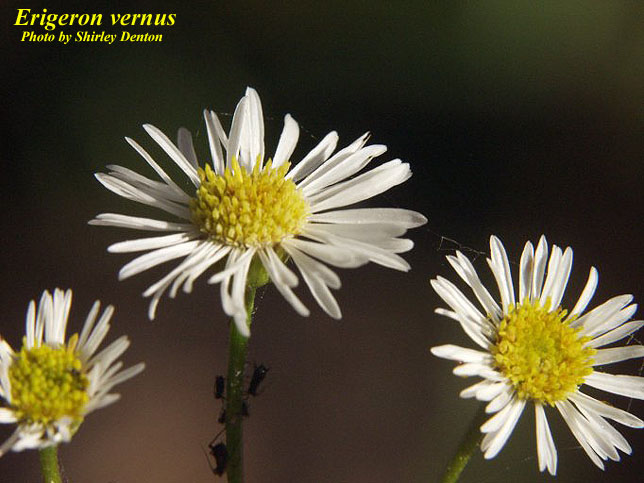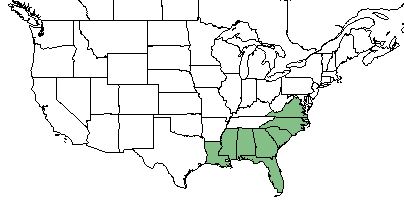Erigeron vernus
Common name: early whitetop fleabane [1], whitetop fleabane [2]
| Erigeron vernus | |
|---|---|

| |
| Photo by the Atlas of Florida Plants Database | |
| Scientific classification | |
| Kingdom: | Plantae |
| Division: | Magnoliophyta - Flowering plants |
| Class: | Magnoliopsida - Dicots |
| Order: | Asterales |
| Family: | Asteraceae |
| Genus: | Erigeron |
| Species: | E. vernus |
| Binomial name | |
| Erigeron vernus L | |

| |
| Natural range of Erigeron vernus from USDA NRCS Plants Database. | |
Contents
Taxonomic Notes
Synonyms: none.[3]
Varieties: none.[3]
Description
E. vernus is a perennial forb/herb of the Asteraceae family native to North America. [1] Average maximum root depth was found to be 9.5 cm, and average root porosity was found to be 12.5 percent.[4] It also has a long-lived life cycle.[5]
Distribution
E. vernus is found along the southeastern coast of the United States from Louisiana to Virginia.[1] It is considered a southeastern coastal plain endemic species.[6]
Ecology
Habitat
E. vernus proliferates in wet savannas, seepages, and interdunal swales. [2] Specimens have been collected from edge of pond, dry loamy sands, wet pine flatwoods, hardwood swamp, peaty ditch, cypress swamp, prairie, hillside bog, and disturbed areas such as next to a track field and roadside ditches. [7] It has been noted that E. vernus is abundant in areas with hog rooting. [8] It is listed by the USDA Natural Resources Conservation Service as an obligate wetland species that only can be found in wetland habitats.[1] In Florida, E. vernus is considered an indicator species of lower panhandle savannas, and is a common member of panhandle seepage savannas.[9]
Associated species include Sarracenia flava, Rhynchospora oligantha, Aristida stricta, Serenoa repens, Eragrostis refracta, Juncus abortivus, Juncus megacephalus, Juncus debilis, Rhexia virginica, Lachnanthes caroliana, Ludwigia linearis, Hypericum fasciculatum, and others.[7]
Erigeron vernus is an indicator species for the Lower Panhandle Savannas community type as described in Carr et al. (2010).[10]
Phenology
Generally, E. vernus flowers from late March until June.[2] It has been observed flowering January through July and September. [11]
Fire ecology
E. vernus is commonly found in fire-dependent pinelands.[9] It has been considered fire-stimulated. It largely flowers after a recent burn, particularly in pine savanna habitats. [8]
Use by animals
E. vernus has poor forage value.[12] This species supports conservation biological control through attracting predatory or parasitoid insects that in turn prey on pest insects.[13]
Conservation, cultivation, and restoration
This species is imperiled in Virginia, and possibly extirpated in Washington D.C.[14]
Cultural use
Photo Gallery
References and notes
- ↑ 1.0 1.1 1.2 1.3 USDA Plant Database https://plants.usda.gov/core/profile?symbol=ERVE
- ↑ 2.0 2.1 2.2 Weakley, A. S. (2015). Flora of the Southern and Mid-Atlantic States. Chapel Hill, NC, University of North Carolina Herbarium.
- ↑ 3.0 3.1 Weakley, A.S. 2015. Flora of the southern and mid-atlantic states. Working Draft of 21 May 2015. University of North Carolina at Chapel Hill, Chapel Hill, North Carolina.
- ↑ Brewer, J. S., et al. (2011). "Carnivory in plants as a beneficial trait in wetlands." Aquatic Botany 94: 62-70.
- ↑ Hinman, S. E. and J. S. Brewer (2007). "Responses of Two Frequently-Burned Wet Pine Savannas to an Extended Period without Fire." The Journal of the Torrey Botanical Society 134(4): 512-526.
- ↑ Sorrie, B. A. and A. S. Weakley (2001). "Coastal plain vascular plant endemics: Phytogeographic Patterns." Castanea 66(1/2): 50-82.
- ↑ 7.0 7.1 URL: http://herbarium.bio.fsu.edu. Last accessed: June 2018. Collectors: Ed Keppner, Lisa Keppner, Loran C. Anderson, Cecil Slaughter, R. Kral, Ann F. Johnson, R.K. Godfrey, Morris Adams, A.F. Clewell, E. Tyson, Paul L. Redfearn, Robert Norris, Bruce Hansen, JoAnn Hansen, D.W. Mather, Lloyd H. Shinners, Grady Reinert, N. Summerlin, M. Knott, J.P. Gillespie, W.D. Reese, E.M. Hodgson, C.Jackson, Gerould Wilhelm, Mabel Kral, George Cooley, Richard Eaton, James D. Ray, K. Craddock Burks, R. Komarek, J.M. Kane. States and counties: Florida (Bay, Wakulla, Putnam, Flagler, Nassau, Franklin, Liberty, Volusia, Washington, Walton, Hamilton, Jefferson, Okaloosa, Marion, Escambia, Osceola, Calhoun, Union, Jackson, Bradford, Charlotte, Martin, Citrus, Dixie, Jefferson) Georgia (Thomas)
- ↑ 8.0 8.1 Observation by Edwin Bridges comment on Jimi Cheak post, August 11, 2017, posted to Florida Flora and Ecosystematics Facebook Group. Cite error: Invalid
<ref>tag; name "FFE" defined multiple times with different content - ↑ 9.0 9.1 Carr, S. C., et al. (2010). "A Vegetation Classification of Fire-Dependent Pinelands of Florida." Castanea 75(2): 153-189.
- ↑ Carr, S.C., K.M. Robertson, and R.K. Peet. 2010. A vegetation classification of fire-dependent pinelands of Florida. Castanea 75:153-189.
- ↑ Nelson, G. PanFlora: Plant data for the eastern United States with emphasis on the Southeastern Coastal Plains, Florida, and the Florida Panhandle. www.gilnelson.com/PanFlora/ Accessed: 21 MAY 2018
- ↑ Hilmon, J. B. (1964). "Plants of the Caloosa Experimental Range " U.S. Forest Service Research Paper SE-12
- ↑ [[1]] Lady Bird Johnson Wildflower Center. Accessed: May 9, 2019
- ↑ [[2]] NatureServe Explorer. Accessed: May 9, 2019